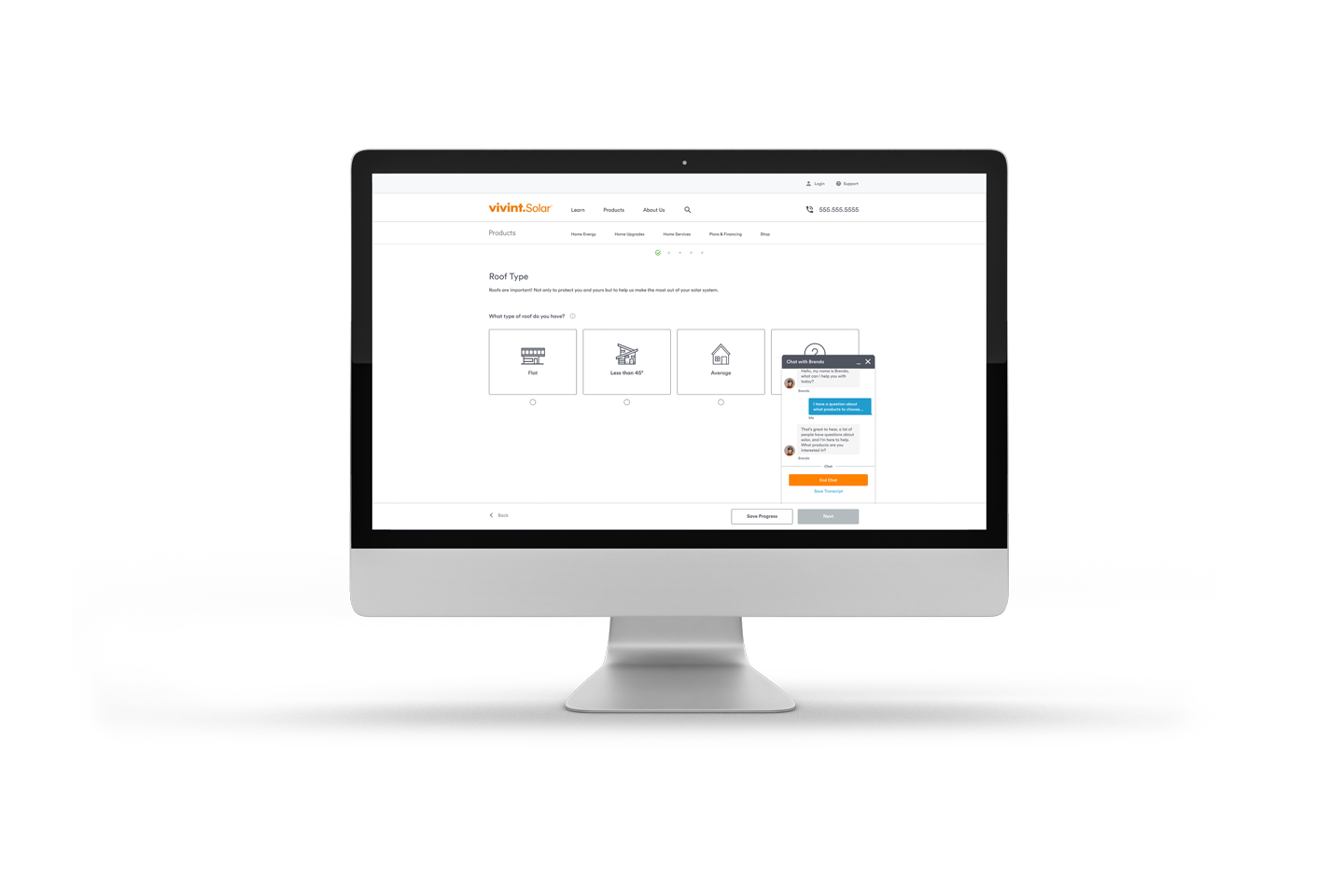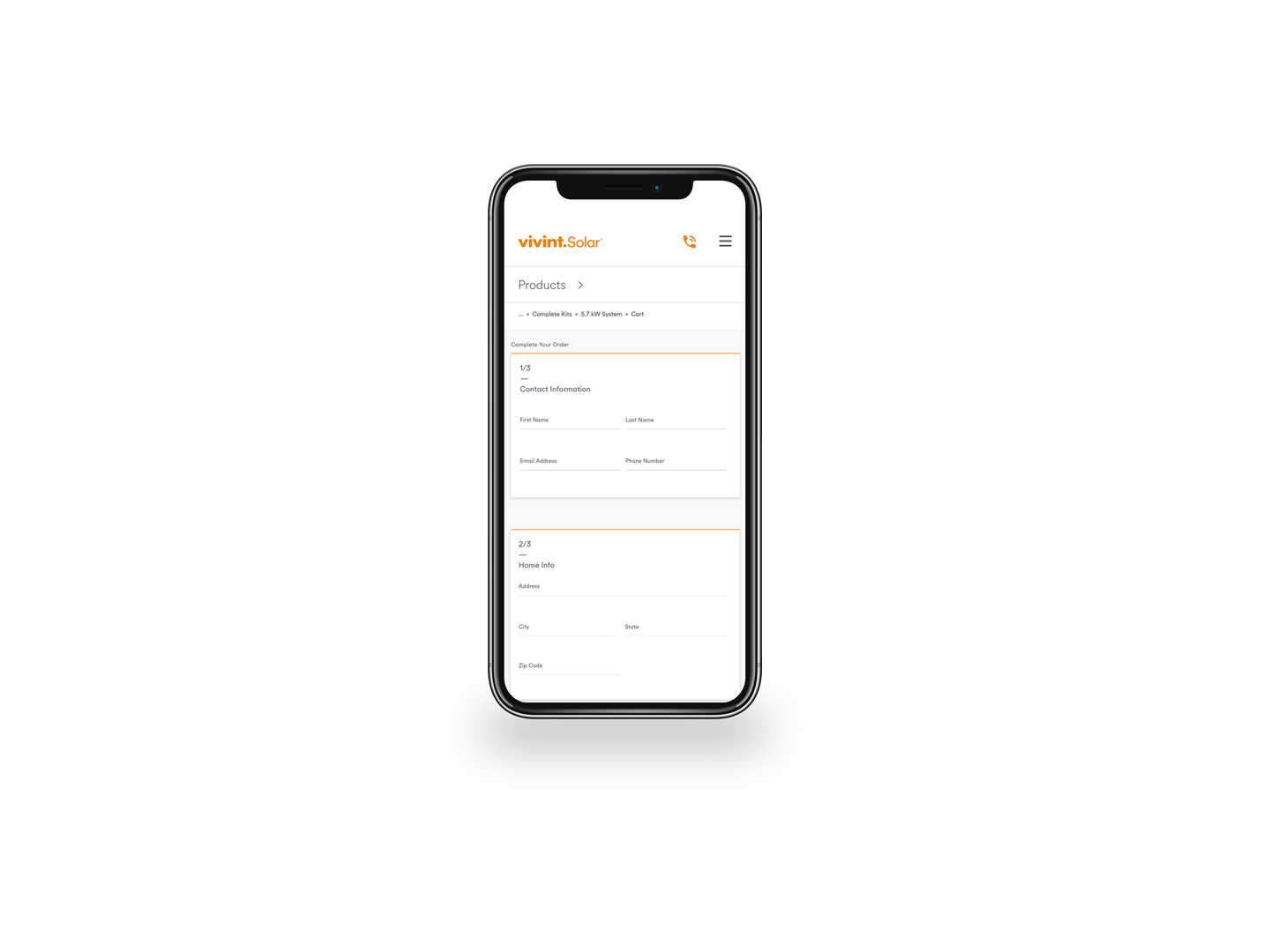Vivint Solar | E-commerce
Disrupting a disruptive industry with personalized e-commerce experiences
How personalized e-commerce experiences lead a disruptive brand to emerge as the second-largest renewable home energy company in the world.
Self-service user journey screens
Client overview:
Vivint Solar started selling solar panels as a subsidiary of Vivint Inc. in 2007 through a direct-to-home (D2H) sales model. Later, in 2011 Vivint Solar became branched out and formed its corporation, facilitating the ability to scale dramatically across the country. In 2017, Vivint Solar expanded its product line from solar and intelligent technology to electric vehicle charging and home battery backup systems. Homeowners benefit from all the clean, affordable energy they need to produce, store and consume all from their own homes.
Business rationale:
As solar hardware advances in terms of better features and reduced pricing, soft costs related to sales and marketing have stayed fixed. As federal and local tax incentives begin to step down, renewable home energy companies face challenges in continued growth and profitability. Since 2007, more and more competitors have entered the residential solar market, and the need to stand out is more important than ever. While still viable in many respects, the standard, direct-to-home sales model has inherent constraints, especially during uncertain times (re: COVID-19 pandemic). At the same time, consumers are responding with greater demand and expressing their desire to explore and purchase renewable home energy products through digital channels.
Primary growth strategy: Enter a new competitive arena through a digital self-service channel. Consumers can discover and explore clean energy products, receive personalized recommendations, and make online purchase orders.
Notable trends: Understanding our customers and bringing them to life
Digital commerce went from 13.2% in 2018 to 16% in 2019 and more than 27% in 2020 during the first 4 months of the global pandemic.
In an industry survey comprised of solar customers and those considering solar, 6x as many homeowners said they preferred learning about solar through digital commerce to receiving an in-person consultation.
Another survey conducted in 2019 concluded that what holds most customers back from choosing clean energy is the lack of education and certainty about which products to choose and what company to go solar.
In parallel industries, personalization technology has shown higher conversion rates of ~202% and an increase of ~17% in revenue.
3 primary user segments emerged based on our findings:
Early Adopters (37.4%)
Metric-Hungry Homeowners (44.4%)
Cost Cautious (18.2%)
Homeowners are beginning to expect personalized product experiences and offers through digital-first channels
Using personalization technology, we were able to advance our segmentation in 3 formats:
Direct response — Using A/B testing and multivariate patterns to identify user interest and response.
Demographics — based on your geography, age, and whether or not you own a home, you may be automatically disqualified from receiving certain products and services.
User journey status — Top-of-Funnel (TOF); Middle-of-Funnel (MOF); Bottom-of-Funnel (BOF).
Solution Summary: Advancing the user journey
Data-driven analysis & segmentation: Research and analyze customer base to identify common patterns and characteristics for segmentation. Understand our customers' journey and experiences at every user touchpoint.
Personalize & convert: Using needs and affinity-based segmentation, implement and execute a personalization strategy. Help users find what they're looking for, tailor their solutions based on best practices and expert recommendations, and guide them through advancing their journey.
Measure & optimize: Identify metrics to measure the performance of every journey based on what we find to be most important to users. Identify areas of improvement and iterate through connected strategy, content, design, technology, and analytics.
Design-thinking workshops:
In design-thinking workshops, designers work together with marketing strategists, business stakeholders, content creators, end-users, and developers to map problems to viable, scalable solutions.
User experience (UX) design
4 critical-path user journeys were ready for execution based on data-driven insights and future-focused product vision
Expanded product set — enables broader appeal, extended reach, and the ability to still serve people with clean energy, regardless of qualification status for residential offerings.
Product Selector — Minimum viable product, provides education and personalized recommendations based on simplified user inputs.
Cart E-Commerce — Combines content marketing with the ability for users to purchase products and kits wholesale from an online store.
Full Self-service — Enables users to complete an entire self-service journey from product education to personalized product offerings and online purchase orders.
Journey blueprints


Tech Foundation
Tech foundation: Building a sustainable, connected, and personalized technology framework
Using microservice architecture, we facilitated the scale needed for personalized, end-to-end user experiences.
Connected microservices include Workflow Automation; Digital Asset Management (DAM); Headless Content Management (CMS); Design Language System (DLS); User Database Platform (CDP); and Automated Decisioning.
Putting it all together
Expanded product solutions: Enabling the future we all want
Expanding our product set at the TOF expands our reach, broadens our appeal, and enables better customer experiences over time.
Using content marketing to expand our reach and our appeal across demographics
Content marketing ranks in TOF and attracts new users who are not actively searching based on solar keywords.
Based on user demographics, affinity categories, and active journeys, stories and product cards display on demand.
Designing product pages that build trust
Keeping in mind that disruptive technology usually carries a sense of uncertainty, and most users will encounter us multiple times before making a purchase decision, trust became the primary motivating factor in whether or not a user would advance their journey with us. We adapted our content, interface, and journey pathways to facilitate greater empathy and information-sharing to add value.
Critical elements of trust:
Empathy
Information
Inspiration
Empowerment
Recognition
Connection
Consistency
Authenticity
Here’s what trust-building design looks like:
Messaging focuses on clear and consistent value propositions
Value propositions are straightforward and consistent, not techy or overly qualified
Product selector
Remember that most users are looking to learn more and build trust with us before deciding. The product selector provides a low-friction route for people to learn and build trust with our product and brand. The product selector gives users the ability to explore products and services and receive personalized recommendations based on their needs.
Personalized recommendations, picked just for you
Simplified flows and user inputs facilitate a mobile-first user experience, given that more than 70% of users engage via mobile devices.
Personalized support from experts you trust every step of the way.
Users can get professional support on-demand via phone or chat.











Cart eCommerce
Homeowners used to make a purchase decision with a sales rep to help walk them through the process. Remember that residential solar energy products can be incredibly complex, requiring multiple person-hours dedicated to engineering, permitting, and other resources. Cart-based e-commerce creates a low-cost path for anyone (customers and businesses) to purchase clean energy products at near wholesale pricing, having them shipped right to their door.
Wholesale kits purchased through e-commerce are cheaper because they require fewer person-hours and engineering resources.










End-to-end self-service
It's been said before that "solar is sold, not bought." End-to-end self-service changes all that. We leveraged additional microservices into an all-new, end-to-end micro application for users by combining what we'd built and learned from our product selector and cart e-commerce micro-apps. This application includes customized product offerings and recommendations and self-service checkout and shipping (should you choose). In addition, we added a savings estimator (due to popular demand) and self-design and self-scheduling features that enhance the user experience while simultaneously reducing person-hours and engineering overhead.
A one-of-a-kind experience that connects with people where they are and deflects the competition.
Open APIs from sources like Google Project Sunroof provide critically essential data like available sun hours, roof availability, and energy offset.
Using what we had learned from our product selector, we simplified the number of necessary inputs and information for a mobile-first experience.
















Results summary
Product pages increased site traffic by 120% YOY for 3 years.
The visitor to lead generation increased from a rate of >1% in 2018 to ~3.2% in 2021.
Lead to opportunity conversion (used for lead quality benchmarking) improved from >1% in 2018 to over 8% sitewide in 2021.
Total install volume 10x'd from a rate of ~3% in 2018 to ~30% by the end of 2020.
Improved system economics with improved product composition (increased attach rate of smart home, EV, and battery products) and overall profitability metrics.






























